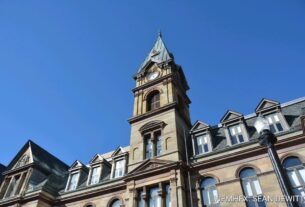**** FINANCE/TREASURY BOARD Media Release
Nova Scotia Tables Fifth Consecutive Balanced Budget
—————————————————————
Improving the lives of Nova Scotians, building on economic success, modernizing much-needed infrastructure and fostering confidence in a brighter future are the focus of government’s fifth consecutive balanced budget.
Finance and Treasury Board Minister Karen Casey tabled Budget 2020-21: Better Together today, Feb. 25.
“As a new decade begins, I am hopeful and optimistic about the future of our province. All Nova Scotians deserve to see benefits from the province’s stronger economy and our positive fiscal position,” said Ms. Casey. “Budget 2020-21 supports Nova Scotians who may not have been feeling the success of the province. For our province to thrive now and in the future, we need to ensure our citizens receive the programs and services they need.”
Budget 2020-21 estimates a surplus of $55 million with revenue of $11.60 billion and expenses, after consolidation adjustments, of $11.54 billion. It also projects balanced budgets in each of the following three years.
Highlights of Budget 2020-21 include:
— $18 million to increase the low-income threshold for the Nova Scotia Child Benefit and increase the amounts families will receive and help address child poverty. Families with incomes below $34,000 will now be eligible, benefiting almost 28,000 families and 49,000 children
— $7.6 million increase to support youth with complex needs
— $1.9 million to expand prevention and early intervention child welfare programming for children and families at risk
— $1.5 million for residential placements and programming supports to protect sexually exploited youth
— $16.6 million increase for programs that support adults and children with disabilities
— $798,000 increase to the Accessibility Directorate, for total of $1.9 million, to support its work in collaboration with persons with disabilities, municipalities, businesses, post-secondary institutions and others to achieve the goal of an accessible Nova Scotia by 2030
— $1.4 million increase to support a comprehensive provincial approach to combat human trafficking
— $500,000 increase to expand the Emergency Providers Fund, doubling the fund for a total of $1 million
— $18.7 million increase for the second year of initiatives to provide safe, suitable, and affordable housing under the Nova Scotia Action Plan for Affordable Housing, part of the National Housing Strategy and other housing priorities
— $4.1 million increase for the Integrated Action Plan to Address Homelessness
— $2 million to sustain the Affordable Renters Program to lower energy bills for low-income renters, to make their homes more comfortable and to ensure rents remain stable by increasing energy efficiency upgrades to multi-unit buildings
Health-care services:
— $75.3 million this year for the new Doctor’s Master Agreement to improve the recruitment and retention of medical professionals – this investment will mean that family, emergency and anesthesia doctors will be the highest paid in Atlantic Canada and other specialties like psychiatry, obstetrics and gynecology will be among the highest paid in this region
— $750,000 increase this year to further develop collaborative care teams to make it easier for Nova Scotians to see a doctor or other primary care clinicians, for a total of
$28.4 million annual investment
— $4.7 million this year to continue developing the next generation of doctors at Dalhousie University Medical School
— $692,000 to expand the number of nursing seats by 70 at Cape Breton University, and Dalhousie Yarmouth Campus
— $3.2 million to support the implementation of the Human Organ Tissue Donation Act that will make it possible for all Nova Scotians to donate their organs and tissue, unless they opt out – Nova Scotia is the first jurisdiction in North America with this legislation
— $5.3 million increase to enhance long-term care in the province, for total long-term care funding of $612.4 million
— $20.9 million to help Nova Scotians access the medications they need which includes new cancer drugs, seniors pharamcare and low-income family drug support.
— $550,000 increase, for a total of $316.5 million, in mental health and addictions funding, to expand and sustain mental health services and supports
— increasing the tax on cigarettes, cigars and other forms of tobacco to support efforts to reduce smoking rates, particularly among youth
–introducing a tax on vaping products starting September 2020 and requiring all retailers to obtain permit to sell vaping products starting July 2020 to support efforts to decrease youth vaping. Nova Scotia is one of the first provinces to do this
Pre-primary:
— $17.5 million increase for the rollout of 48 additional pre-primary school communities in 2020-21 for a total budget of $51.4 million – with this investment every four-year-old in the province will have access to a pre-primary program, with a total of 253 pre-primary school communities
— $4 million to provide bus service for eligible pre-primary students
Building on Economic Success:
— $70.5 million to reduce the corporate tax rate by two per cent to 14 per cent to help Nova Scotia businesses become more competitive, innovate, reinvest in their businesses and grow
— $10.5 million to reduce the small business tax from three per cent to 2.5 per cent, savings which helps companies invest back in their businesses and employees
— building on 2019-20 investments, such as the $50 million trust and other transition commitments, $5 million in each of the next two years for a new Forestry Innovation Rebate Program for forestry companies with eligible projects that improve production processes or diversify products and markets
— $1 million, for a total annual investment of $2.7 million, to move toward ecological forestry, including more funding for silviculture, in line with the Independent
Review of Forestry Practices
— $16.3 million for the operating grant for the Nova Scotia to Maine ferry
Investing in Modern Infrastructure:
— $154.4 million to support the largest health-care redevelopment projects in the province’s history – the QEII New Generation project and the Cape Breton Regional Municipality Health Care Redevelopment
— $54.3 million for construction, repair and renewal of hospitals and medical facilities across the province
— $265.6 million increase in capital investments this year to build and renovate 16 schools and for the purchase of 30 P-3 schools
— $85.3 million more, for a total of $385.3 million, for Nova Scotia’s roads, highways and bridges, with continued work on multi-year projects to twin 100-series highways, including Highway 101 (Three Miles Plains to Falmouth), Highway 103 (Ingramport to Hubbards), Highway 104 (Sutherlands River to Antigonish) and the Sackville-Bedford-Burnside Connector.
— funding for a new arts district on the Halifax waterfront that will provide access to art, culture, world-class exhibitions and festivals
— funding to build the NSCC Marconi Campus in Sydney
Confidence in a Brighter Future:
— $15 million increase to continue implementing the recommendations from the Commission on Inclusive Education to create a more inclusive education system for all students, bringing the total investment to $45 million
— $3.6 million increase to the university operating grant as part of the multi-year memorandum of understanding with post-secondary institutions
— $2.2 million increase to the Student Loan Forgiveness Program for a total budget of $11.6 million
— $8.3 million increase to the Efficiency Nova Scotia Home Warming Program to offer home energy assessments and upgrades for homeowners
— $1.5 million provincial increase for green infrastructure stream projects to help reduce greenhouse gas emissions while ensuring citizens are not penalized by higher fuel and electricity costs, for a total provincial contribution of $6.5 million under the Canada Infrastructure Plan
— $1.6 million for the startup of a Green Fund to support programs to respond to climate change
Quick Facts:
— Budget 2020-21 contains $1.04 billion for capital projects
— the budget also contains the final forecast for 2019-20, which updates the surplus to $41.1 million
— additional appropriations related to the forecast, totalling $133 million, account for unbudgeted spending by nine departments and assistance to universities
Additional Resources:
For more budget highlights visit http://novascotia.ca/budget/
To view the budget documents, visit http://beta.novascotia.ca/documents/budget-documents-2020-2021




